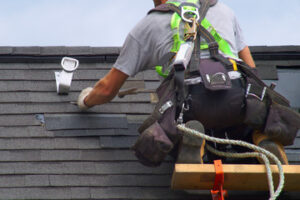A roof is a home’s first line of defense against blazing sun, pounding rain, and gusty winds. It also protects your belongings, and gives your house its signature style.

Before the roofing crew begins, they prepare your property by setting up tarps and covering anything not in the open. They will also clear your attic to avoid damage to sentimental items stored there. Visit https://www.ellingsonroofing.com/roofing-missoula-mt to learn more.
Before you begin shingle installation, it is important to acquire the right tools and materials. Moreover, it is critical to choose a clear day to work on the roof. Rain can cause the underlayment and shingles to deteriorate. In addition, it is a good idea to make sure that the gutters are clean and free from clogs. This will help prevent water from backing up under the shingles and causing leaks in the interior of your home.
The first course of shingles should be laid directly on top of and flush with the starter strip. Then nail the shingles with four nails per shingle, as instructed by the manufacturer’s package instructions (six nails for high-wind areas). It is also helpful to snap horizontal chalk lines up the roof to ensure that rows are straight. Finally, make sure that you expose 5 in. of the shingle tabs when you nail the first shingle at the valley, and do the same when laying each subsequent row up to the ridge.
If you have a dormer, chimney, skylight or other roof penetrations, it’s a good idea to use flashing materials in conjunction with the shingles. This will protect these difficult-to-reach areas of the roof from moisture and insects.
If you are using metal panels for your roof, it’s a good idea to consult with a roofing professional. These are a bit more complicated to install than asphalt shingles, and it’s important that the seams between panels are properly sealed. In addition, it’s a good idea to apply a layer of waterproof sealant over the panel seams and around any flashing. This will help to prevent moisture from getting into the attic and causing damage to insulation and drywall.
Tiles
When deciding on tile roof installation, you must balance durability, ease of installation and aesthetics. Tile roofs come in a wide variety of colors and styles, from flat tiles to pantiles that interlock. Some tiles are made of natural materials while others are synthetic or composite. Each type of tile has its own advantages and disadvantages. For example, clay tiles are durable and long-lasting but require specialized tools for installation. Composite tiles are made of sustainable mixtures and can mimic the look of any other style of tile roof. They are non-porous, so mildew and mold do not grow, but they can still collect dirt and must be regularly cleaned.
The style of your tiles will also impact your costs. For example, flat tiles are typically made of concrete or clay and cost between $7 and $10 per square foot. Pantile roof tiles are S-shaped and offer a distinctive visual appearance. They are comparatively easy to install and generally cost $8 to $10 per square foot. Other popular tile styles include true barrel tiles, which have a tapered shape and are ideal for curved roofs, and Mediterranean tiles, which have a waved pattern and are best suited to regions that experience heavy rains.
Before laying the tiles, your roofer will apply underlayment to the roof. This will help prevent water from seeping into the roof if the tiles become loose or damaged. It is important to make sure that the underlayment covers all areas of the roof, including ridges and valleys.
Once the underlayment is in place, your roofer will begin laying the tiles. They will usually start at one end of the roof and work across the length. The tiles should overlap by 3 inches minimum, and the installer will nail them into place with roof nails. If you’re using tiles that tightly interlock, it may not be necessary to nail them into sheathing or battens.
Metal Panels
Metal panels are a durable facade option that can be used in place of traditional shingles or tiles on roofs. They are available in a variety of styles, colors, and finishes to complement any architectural style. They are also highly energy efficient and offer excellent fire resistance. Lastly, they are durable and can increase the resale value of a property.
Unlike many other roofing materials, metal panels are made with lightweight steel or aluminum. This makes them easier to handle during installation and reduces the amount of stress on the underlying structure of the building. Additionally, they are often coated with a protective finish that prevents the buildup of debris and dirt.
Before installing metal panel roofs, it is important to install an underlayment. This material will protect the decking of your roof from moisture and water. It is recommended to use a felt or synthetic underlayment that is the same color and gauge as your metal panels.
Once the underlayment is installed, it is time to install the starter lock strips. These strips are placed on the eaves and rakes of your roof to hold the standing seam metal panels in place during construction. It is crucial to install these properly, as they are what keep the roof watertight and protected from strong storms.
A ridge cap is then installed to cover the gap between the panels and the roof ridge. To do this, you will need to snap a chalk line where the ridge of the roof is located and then apply sealant tape to the area. Once the ridge cap is in place, it should lap both sides of the roof evenly.
Downspouts
Downspouts (also known as eavestroughs) are installed on the sides of a roof and collect rainwater. They then channel water into a drain or gutter at the bottom of the roof slope, often with a small ramp to divert the flow and keep it away from the home’s foundation. Downspouts may also drain directly into a storm sewer or other outdoor drainage system.
One of the most important aspects of any good roof is directing rainwater downward rather than overflowing into lower levels of the house. Overflowing gutters create moisture issues that can lead to mold, rot, leaks and even moss growth on the shingles. Gutter downspout extensions, which are long pieces of square tube, solve these problems by guiding watter from upper level gutters downward.
To install a downspout extension, measure from the gutter to the ground and subtract about seven or eight inches to account for elbows at the top and bottom of the downspout. Next, use a hacksaw to cut a long section of downspout. Using metal tin snips, cut the ends of this piece to a 45-degree angle. Finally, crimp the edges with a gutter crimper to ensure a watertight fit.
Screw the downspout extension into place, making sure it’s positioned so that water will be directed away from walkways and areas where pooling might cause an issue. To finish, wrap straps around the downspout, secure them with screws and spray a bit of paint to match your siding’s color. For a more refined look, you can add gutter sealant to the joints. A cordless drill is essential for drilling holes and driving screws. A good quality hacksaw and tin snips are also helpful for cutting downspout sections and elbows to the correct lengths, and you’ll need to have some self-tapping screws for wood or concrete walls.
Valleys
Roof valleys are susceptible to damage and leaks because they are located in the area where two sloping roof sections meet. However, these areas can be protected by regular maintenance and proper roofing materials. The most common roof valleys are open and closed, and both have advantages and disadvantages.
Woven valleys are created by overlapping shingles and provide a more attractive appearance, but they require more material than straight-cut valleys. The extra material cost may be offset by the long-term durability and beauty of woven valleys.
Straight-cut valleys are more efficient than woven valleys because they use fewer materials and are easier to install. They do not offer the same aesthetic appeal as woven valleys, but they are an excellent choice for roofs with minimal slope.
To protect roof valleys, it is important to ensure that they are well-maintained and insulated. For example, roof valleys can be clogged with debris like twigs, dirt, grime, and leaves, which can disrupt water drainage. Regularly cleaning your roof valleys can prevent this problem and help extend the lifespan of your roofing system.
Before installing any roof flashing, it is essential to remove the existing shingles in the area and inspect the sheathing underneath. If you notice any soft or rotted sections, you should replace them with new sheathing. Once you have the new sheathing in place, you can proceed to the next step of your roofing project:
Start by installing a sheet of metal roof flashing on the bottom of the valley. Ensure that it overlaps by at least six inches and seal it with an asphalt sealer. This will add an extra layer of protection against water infiltration.


